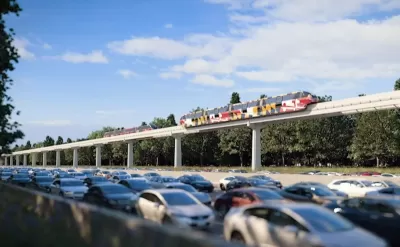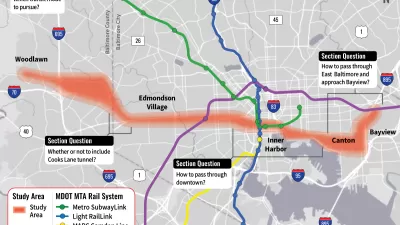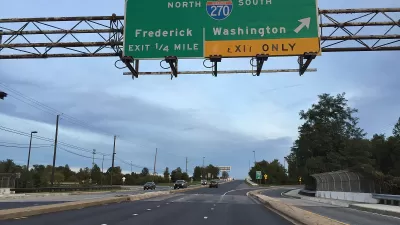The MDOT study found that the monorail line would draw many of its riders from existing public transit systems.

A recent study by the Maryland Department of Transportation (MDOT) found that a proposed monorail line would be a "viable" but not optimal option for reducing traffic on the Interstate 270 corridor. "The corridor," reports Katherine Shaver in the Washington Post, "is Montgomery’s hub for biotech companies, and the highway carries commuters between more affordable homes in farther-out suburbs and jobs in Montgomery, Washington and Northern Virginia."
The $4.4-billion monorail project would cut the 28-mile trip between Frederick and the Shady Grove Metro station to 42-46 minutes, but the study projects that one fifth to one third of riders would come from other transit systems rather than from private vehicles. "More development would have to be clustered around potential station sites to generate ridership, and motorists would need a 'behavioral shift' to switch to mass transit, the study said."
Proponents of the monorail argue that the study's ridership estimates are too conservative and that, if funded, the project would nevertheless be a positive step toward more efficient public transit in the region. "MDOT spokeswoman Erin Henson said the agency will seek feedback on the feasibility study from Montgomery and Frederick counties and see whether either includes a monorail in its annual letter, expected this spring, outlining local transportation funding priorities."
FULL STORY: Monorail is a ‘viable’ transit option for I-270 but wouldn’t reduce traffic, study says

Alabama: Trump Terminates Settlements for Black Communities Harmed By Raw Sewage
Trump deemed the landmark civil rights agreement “illegal DEI and environmental justice policy.”

Study: Maui’s Plan to Convert Vacation Rentals to Long-Term Housing Could Cause Nearly $1 Billion Economic Loss
The plan would reduce visitor accommodation by 25% resulting in 1,900 jobs lost.

Planetizen Federal Action Tracker
A weekly monitor of how Trump’s orders and actions are impacting planners and planning in America.

Waymo Gets Permission to Map SF’s Market Street
If allowed to operate on the traffic-restricted street, Waymo’s autonomous taxis would have a leg up over ride-hailing competitors — and counter the city’s efforts to grow bike and pedestrian on the thoroughfare.

Parklet Symposium Highlights the Success of Shared Spaces
Parklets got a boost during the Covid-19 pandemic, when the concept was translated to outdoor dining programs that offered restaurants a lifeline during the shutdown.

Federal Homelessness Agency Places Entire Staff on Leave
The U.S. Interagency Council on Homelessness is the only federal agency dedicated to preventing and ending homelessness.
Urban Design for Planners 1: Software Tools
This six-course series explores essential urban design concepts using open source software and equips planners with the tools they need to participate fully in the urban design process.
Planning for Universal Design
Learn the tools for implementing Universal Design in planning regulations.
Caltrans
Smith Gee Studio
Institute for Housing and Urban Development Studies (IHS)
City of Grandview
Harvard GSD Executive Education
Toledo-Lucas County Plan Commissions
Salt Lake City
NYU Wagner Graduate School of Public Service





























